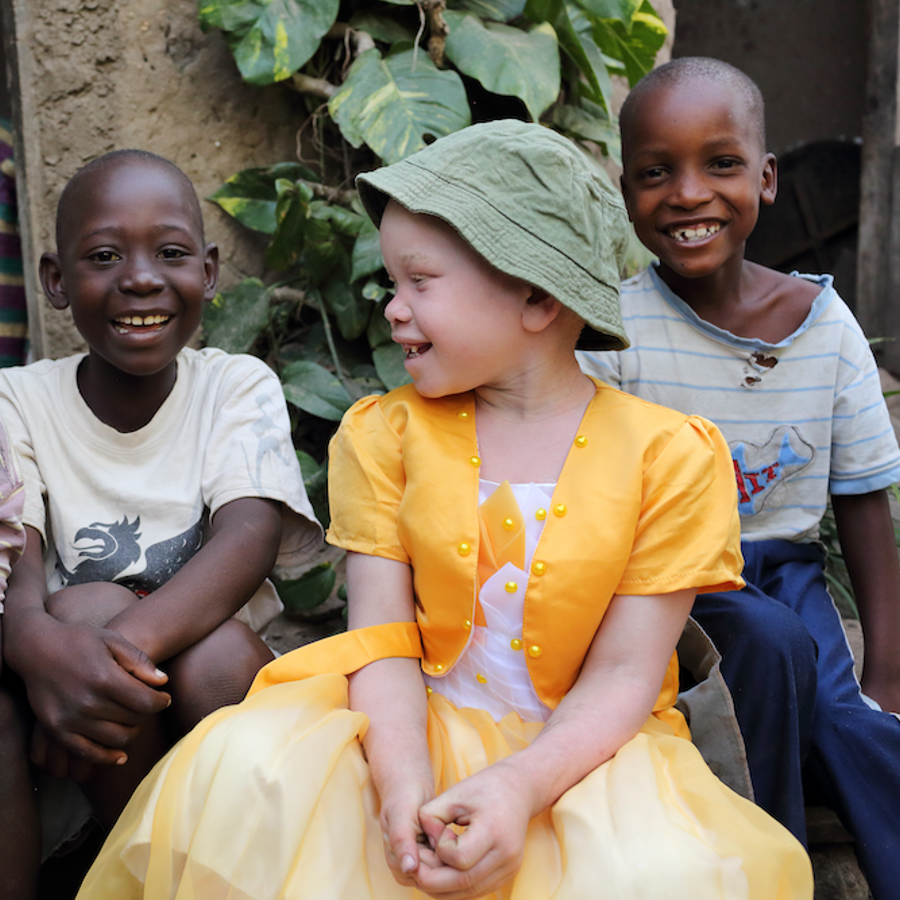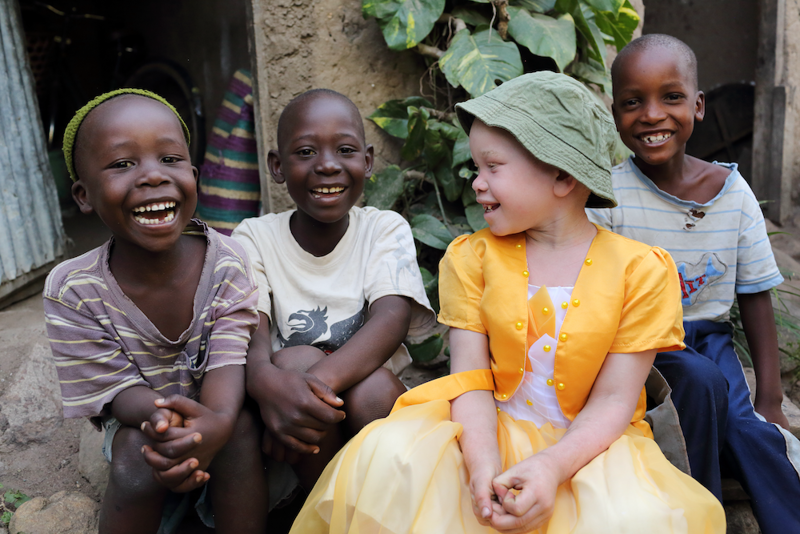
Can two parents with albinism have an unaffected child?
May 31, 2023

- Related Topics:
- Albinism,
- Pigmentation traits,
- Autosomal recessive inheritance,
- Classical genetics
Marie from Nigeria asks:
"I’m a rufous albino and my partner is an oca2 albino. Can we produce non-albino children?"
Yes, it’s certainly possible for two people with albinism to have unaffected children! This is actually pretty common when the two parents have different types of albinism.
Albinism is a group of conditions associated with decreased (or absent) pigmentation in the skin, hair, and eyes. People affected by albinism frequently have fair skin and light-colored hair. They are more at risk for skin cancers caused by long term sun exposure. Additionally, some forms of albinism reduce pigmentation in the iris (colored part of the eye) and retina (light sensitive tissue in the back of the eye) which can cause vision problems.
Albinism is caused by genetic differences, which can be passed on to a child. However, since your albinism is caused by a different gene than your partner’s albinism, your children will likely be unaffected. Read on to learn more about the specifics of how albinism is passed on from generation to generation.

Albinism is caused by genetic differences
Every person has two copies of each gene in their DNA. One copy inherited from each parent.
Albinism is specifically caused by rare differences in genes that control pigmentation in skin, hair, and eyes. It is usually inherited in a recessive pattern. This means that you have to inherit the genetic difference from both parents in order to show the trait.
If someone inherits even one working pigment-production gene, they will have pigmentation in their skin, hair, and eyes. But if neither of the two inherited genes can produce pigment, the person will have albinism.
But there are several different types of albinism, which are each caused by different rare genetic changes. Here are just a few different types:
Variants in the TYR gene cause type 1 oculocutaneous albinism, where the person has very light skin, white hair, and pale irises.
Variants in the OCA2 gene cause type 2 oculocutaneous albinism, where the person has creamy skin color, and light yellow, blond, or brown hair.
Variants in TYRP1 gene cause type 3 oculocutaneous albinism, where the affected individual has reddish-brown skin, ginger/red hair, and hazel/brown eyes. Type 3 is also known as rufous albinism.
|
Type of Oculocutaneous Albinism |
Symptoms |
Gene |
|
Type 1 |
Light skin, white hair, pale irises |
TYR |
|
Type 2 |
Creamy skin, light yellow/blond/brown hair |
OCA2 |
|
Type 3 (Rufous Albinism) |
Reddish-brown kin, ginger/red hair, hazel/brown eyes |
TYRP1 |
You mention your partner has OCA2 albinism, with genetic differences in that gene. But as you have rufous albinism, you probably have genetic differences in your TYRP1 gene instead.
Mendelian genetics
Let’s take a step back and look at how albinism often first shows up in families: when two unaffected parents have a child with albinism.
This happens when both parents are carriers. They may have a relative with albinism, or perhaps just a distant ancestor with it. While the parents don’t have albinism, they each have one genetic difference in a pigmentation gene. If they both happen to pass down the albinism-related genetic difference to their own child, their child would show symptoms.
In our example, we will use the OCA2 gene variant. A is the symbol for the version of OCA2 which does not cause albinism, while a is the version of OCA2 that causes albinism. Since albinism is recessive, only people who are aa will show symptoms.
- AA: Does not have albinism
- Aa: Does not have albinism, but carries the genetic difference
- aa: Has albinism
We can use Punnett squares to figure out the chance that two carriers (Aa) will have a child with albinism (aa). We’ll start with a blank table like this:
|
|
||
Next we put the parents’ gene versions on the side of the table like this:
|
|
A |
a |
|
A |
||
|
a |
Then we fill in the other squares to see what possible combinations their children could inherit. For the top left square, we would put AA since it’s possible for a child to receive an A from each parent.
|
|
A |
a |
|
A |
AA |
|
|
a |
We can proceed to fill the rest of the table out like this:
|
|
A |
a |
|
A |
AA |
Aa |
|
a |
Aa |
aa |
From the finished table, we can predict the probabilities for two parents who are carriers:
- 25% chance of having a child with albinism (aa)
- 50% chance of having a child who is a carrier for albinism (Aa)
- 25% chance of having a child who does not have albinism and is not a carrier (AA)
We can do something similar to figure out the probability that two carriers for rufous albinism will have an affected child. Remember, rufous albinism is caused by genetic differences in an entirely different gene: TYRP1. We can represent the non-albinism version of TYRP1 as B and the version of the gene which causes albinism as b.
|
|
B |
b |
|
B |
BB |
Bb |
|
b |
Bb |
bb |
Variants in one gene or both genes?
Now, how do we put these together to determine if your children will be affected by albinism? We can essentially do similar predictions with Punnett squares like above.
You have albinism caused by TYRP1 (bb). And your partner has albinism caused by the OCA2 gene (aa).
Since albinism is rare, likely you have the more common, non-albinism version of the OCA2 gene (AA). And it’s likely that your partner has the more common, non-albinism version of the TYRP1 gene (BB). Putting those together, you likely are AAbb while your partner is likely aaBB.
In this case, all your children would be AaBb. They would be carriers for both types of albinism but would not show symptoms.
The probabilities would be different if your partner is a carrier for rufous albinism as well (aaBb). This could be especially likely if his family has a history of rufous albinism. If this is the case, there would be a 50% chance that your child will have rufous albinism and a 50% chance they will be unaffected.
Similarly, you could be a carrier for OCA2 albinism (Aabb). In that case, each child would have a 50% chance of inheriting OCA2 albinism and a 50% chance of being unaffected.
Without knowing more about your specific situation, it’s not possible to give a perfect prediction. A doctor or genetic counselor would be the best person to talk to for more information. They’ll be able to help interpret your family histories, or help you find options for genetic testing to better understand the likelihood of passing down specific genetic variants to your children.

Author: Daiyao Zhang
When this answer was published in 2023, Daiyao was a PhD candidate in the Department of Chemical Engineering, studying the effects of matrix stiffness on pancreatic cancer chemoresistance in Sarah Heilshorn’s laboratory. Daiyao wrote this answer while participating in the Stanford at The Tech program.
 Skip Navigation
Skip Navigation
